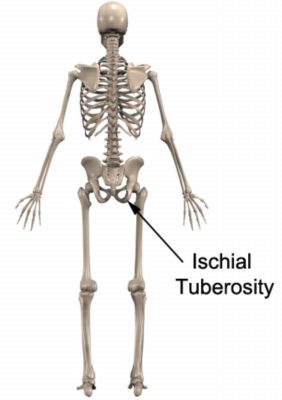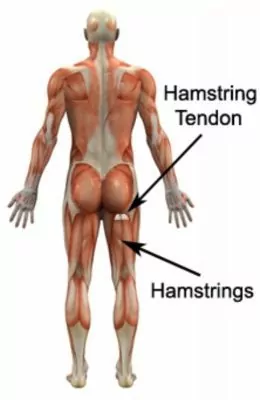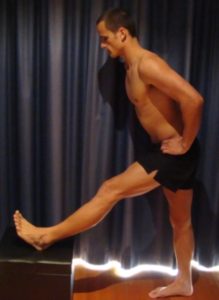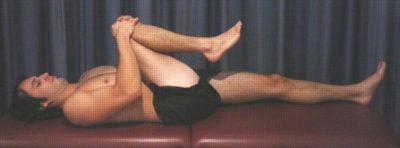Ischiogluteal Bursitis
Updated:
(Also known as Ischial Bursitis)
What is ischiogluteal bursitis?
Ischiogluteal bursitis is a condition that causes pain in the buttock and is characterized by tissue damage and inflammation to the ischiogluteal bursa. A bursa is a small sac filled with lubricating fluid and is designed to reduce friction between adjacent soft tissue layers. The ischiogluteal bursa is located at the base of the pelvis, at the level of the bony prominence known as the ischial tuberosity (figure 1).

The hamstring muscles originate from the pelvis (ischial tuberosity) and insert into the top of the lower leg bones. The hamstring muscles attach to the pelvis via the hamstring tendon (figure 2). The ischiogluteal bursa lies between the hamstring tendon and the pelvic bone (ischial tuberosity).

The hamstring muscles are responsible for bending the knee and straightening the hip during activity and are particularly active during running, jumping and kicking. During contraction of the hamstrings, tension is placed through the hamstring tendon which in turn places friction on the ischiogluteal bursa. Pressure may also be placed on the ischiogluteal bursa during sitting. When these forces are excessive due to too much repetition or high force, irritation and inflammation of the ischiogluteal bursa may occur. This condition is known as an ischiogluteal bursitis.
Causes of ischiogluteal bursitis
Ischiogluteal bursitis most commonly occurs due to repetitive or prolonged activities placing strain on the ischiogluteal bursa. This typically occurs due to prolonged sitting (particularly on hard surfaces) or due to repetitive running, jumping or kicking activities (placing strain on the ischiogluteal bursa via the hamstring tendon). Occasionally, patients may develop this condition suddenly following a direct blow to the ischiogluteal bursa. This may occur due to a fall onto a hard surface.
Signs and symptoms of ischiogluteal bursitis
Patients with ischiogluteal bursitis typically experience pain in the lower buttock. In less severe cases, patients may only experience an ache or stiffness in the buttock that increases with rest following activities placing strain on the ischiogluteal bursa. These activities typically include sitting excessively (especially on hard surfaces), walking, running, jumping, kicking or climbing stairs. The pain associated with ischiogluteal bursitis may also warm up with activity in the initial stages of the condition.
As the condition progresses, patients may experience sharper or more severe symptoms that increase during sport or activity, affecting performance. Patients frequently experience pain on firmly touching the ischiogluteal bursa and hamstring tendon (figure 2). Occasionally, a feeling of lower limb weakness may also be present particularly when attempting to accelerate whilst running.
Diagnosis of ischiogluteal bursitis
A thorough subjective and objective examination from a physiotherapist may be sufficient to diagnose ischiogluteal bursitis. Further investigations such as an Ultrasound, X-ray, CT or MRI scan are often required to assist with diagnosis and assess the severity of the condition.
Treatment for ischiogluteal bursitis

Members Only ContentBecome a PhysioAdvisor Member to gain full access to this exclusive content. For more details see Become a Member. Already a member? Login Now
Prognosis of ischiogluteal bursitis
Most patients with this condition heal well with appropriate physiotherapy and return to normal function in a number of weeks. Occasionally, rehabilitation can take significantly longer and may take many months in those who have had their condition for a long period of time. Early physiotherapy treatment is vital to hasten recovery in all patients with ischiogluteal bursitis.
Contributing factors to the development of ischiogluteal bursitis
There are several factors which can predispose patients to developing this condition. These need to be assessed and corrected with direction from a physiotherapist. Some of these factors include:
- joint stiffness (particularly the hip)
- muscle tightness (particularly the hamstrings and gluteals)
- inappropriate or excessive training
- muscle weakness (especially the hamstrings and gluteals)
- inadequate warm up
- poor biomechanics (e.g. excessive stride length)
- poor core stability
- neural tightness
- leg length discrepancy
- inadequate rehabilitation following a previous buttock injury
Physiotherapy for ischiogluteal bursitis
Physiotherapy treatment is vital to hasten the healing process, ensure an optimal outcome and reduce the likelihood of injury recurrence. Treatment may comprise:
- soft tissue massage
- electrotherapy (e.g. ultrasound)
- stretches
- joint mobilization
- dry needling
- the use of crutches
- ice or heat treatment
- exercises to improve strength, flexibility and core stability
- correction of abnormal biomechanics
- education
- anti-inflammatory advice
- activity modification advice
- a gradual return to activity program
Other intervention for ischiogluteal bursitis
Despite appropriate physiotherapy management, some patients with this condition do not improve adequately. When this occurs the treating physiotherapist or doctor will advise on the best course of management. This may include further investigations such as X-rays, ultrasound, MRI or CT scan, pharmaceutical intervention, corticosteroid injection, draining of the bursa or referral to appropriate medical authorities who will advise on any interventions that may be appropriate to improve the condition.
Exercises for ischiogluteal bursitis
The following exercises are commonly prescribed to patients with this condition. You should discuss the suitability of these exercises with your physiotherapist prior to beginning them. Generally, they should be performed 2 – 3 times daily and only provided they do not cause or increase symptoms.
Your physiotherapist can advise when it is appropriate to begin the initial exercises and eventually progress to the intermediate and advanced exercises. As a general rule, addition of exercises or progression to more advanced exercises should take place provided there is no increase in symptoms.
Initial Exercises
Hamstring Stretch
Begin this exercise with your foot on a step or chair. Keeping your knee and back straight, slowly lean forward at your hips until you feel a stretch in the back of your thigh, knee or buttock (figure 3). Hold for 15 seconds and repeat 4 times at a mild to moderate stretch provided the exercise is pain free.

Gluteal Stretch
Begin lying on your back (figure 4). Using your hands, take your knee towards your opposite shoulder until you feel a stretch in the buttocks or front of your hip. Hold for 15 seconds and repeat 4 times at a mild to moderate stretch provided the exercise is pain free.

Intermediate Exercises

Members Only ContentBecome a PhysioAdvisor Member to gain full access to this exclusive content. For more details see Become a Member. Already a member? Login Now
Advanced Exercises

Members Only ContentBecome a PhysioAdvisor Member to gain full access to this exclusive content. For more details see Become a Member. Already a member? Login Now
Other Exercises

Members Only ContentBecome a PhysioAdvisor Member to gain full access to this exclusive content. For more details see Become a Member. Already a member? Login Now
Rehabilitation Protocol for ischiogluteal bursitis

Members Only ContentBecome a PhysioAdvisor Member to gain full access to this exclusive content. For more details see Become a Member. Already a member? Login Now
 Physiotherapy products for ischiogluteal bursitis
Physiotherapy products for ischiogluteal bursitis
Some of the most commonly recommended products by physiotherapists to hasten healing and speed recovery in patients with this condition include:
To purchase physiotherapy products for ischiogluteal bursitis click on one of the above links or visit the PhysioAdvisor Shop.
 Find a Physio for ischiogluteal bursitis
Find a Physio for ischiogluteal bursitis
Find a physiotherapist in your local area who can treat this condition.
 More Physiotherapy Information
More Physiotherapy Information
- Hamstring Stretches.
- Hamstring Strengthening Exercises.
- Gluteal Stretches.
- Gluteal Strengthening Exercises.
- Core Stability Exercises.
- How to use Crutches.
- R.I.C.E. Regime.
- Ice or Heat.
- Why is my injury not improving?
- View a Return to Running Program that is often used in rehabilitation.
- View the Buttock Pain Diagnosis Guide.
Become a PhysioAdvisor Member
-
 Individual Membership (12 Months)$59.95 for 1 year
Individual Membership (12 Months)$59.95 for 1 year -
 Individual Membership (3 Months)$39.95 for 3 months
Individual Membership (3 Months)$39.95 for 3 months -
 Individual Membership (Yearly)$49.95 / year
Individual Membership (Yearly)$49.95 / year -
 Individual Membership (Monthly)$15.95 / month
Individual Membership (Monthly)$15.95 / month

Link to this Page
If you would like to link to this article on your website, simply copy the code below and add it to your page:
<a href="https://physioadvisor.com.au/injuries/buttock/ischiogluteal-bursitis”>Ischiogluteal Bursitis – PhysioAdvisor.com</a><br/>PhysioAdvisor offers detailed physiotherapy information on ischiogluteal bursitis including: causes, signs and symptoms, diagnosis, treatment, exercises, rehabilitation protocol, physiotherapy products and more...
Return to the top of Ischiogluteal Bursitis.








